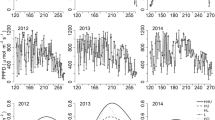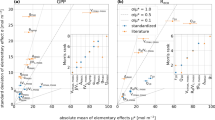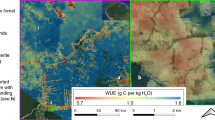Abstract
The surface of bogs is commonly patterned and composed of different vegetation communities, defined by water level. Carbon dioxide (CO2) dynamics vary spatially between the vegetation communities. An understanding of the controls on the spatial variation of CO2 dynamics is required to assess the role of bogs in the global carbon cycle. The water level gradient in a blanket bog was described and the CO2 exchange along the gradient investigated using chamber based measurements in combination with regression modelling. The aim was to investigate the controls on gross photosynthesis (PG), ecosystem respiration (RE) and net ecosystem CO2 exchange (NEE) as well as the spatial and temporal variation in these fluxes. Vegetation structure was strongly controlled by water level. The species with distinctive water level optima were separated into the opposite ends of the gradient in canonical correspondence analysis. The number of species and leaf area were highest in the intermediate water level range and these communities had the highest PG. Photosynthesis was highest when the water level was 11 cm below the surface. Ecosystem respiration, which includes decomposition, was less dependent on vegetation structure and followed the water level gradient more directly. The annual NEE varied from −115 to 768 g CO2 m−2, being lowest in wet and highest in dry vegetation communities. The temporal variation was most pronounced in PG, which decreased substantially during winter, when photosynthetic photon flux density and leaf area were lowest. Ecosystem respiration, which is dependent on temperature, was less variable and wintertime RE fluxes constituted approximately 24% of the annual flux.







Similar content being viewed by others
References
Alm J, Sculman L, Walden J, Nykänen H, Martikainen PJ, Silvola J (1999) Carbon balance of a boreal bog during a year with an exceptionally dry summer. Ecology 80:161–74
Alm J, Talanov A, Saarnio S, Silvola J, Ikkonen E, Aaltonen H, Nykänen H, Martikainen PJ (1997) Reconstruction of the carbon balance for microsites in a boreal oligotrophic pine fen, Finland. Oecologia 110:423–31
Bartlett KB, Harriss RC (1993) Review and assessment of methane emissions from wetlands. Chemosphere 26:261–320
Belyea LR, Clymo RS (1998) Do hollows control the rate of peat bog growth? In: Standen V, Tallis JH, Meade R, Ed. Patterned mires and mire pools. Origin and development, flora and fauna. London: Brittish Ecological Society. pp 55–65
Belyea LR, Clymo RS (2001) Feedback control of the rate of peat formation. Proc R Soc Lond B 268:1315–21
Belyea LR, Malmer N (2004) Carbon sequestration in peatland: patterns and mechanisms of response to climate change. Glob Change Biol 10:1043–52
Bubier JL, Crill PM, Moore TR, Savage K, Varner RK (1998) Seasonal patterns and controls on net ecosystem CO2 exchange in a boreal peatland complex. Glob Biogeochem Cycles 12:703–14
Bubier JL, Crill PM, Mosedale A, Frolking S, Linder E. 2003. Peatland responses to varying interannual moisture conditions as measured by automatic CO2 chambers. Global Biogeochemical Cycles 17
Bubier JL, Moore TR, Crosby G (2005) Fine-scale vegetation distribution in a cool temperate peatland. Can J Bot 84:910–23
Clymo RS (1983) Peat. In: Gore AJP, Ed. Ecosystems of the world. Amsterdam: Elsevier. pp 159–224
Collins JF, Cummins T, Ed. (1996) Agroclimatic atlas of Ireland. Dublin: AGMET
Doyle GJ (1982) The vegetation, ecology and productivity of Atlantic blanket bog in Mayo and Galway, western Ireland. In: White J, Ed. Studies on Irish vegetation. Dublin: Royal Dublin Society. pp 147–64
Doyle GJ (1990) Phytosociology of Atlantic blanket bog complexes in North-West Mayo. In: Doyle GJ, Ed. Ecology and conservation of Irish peatlands. Dublin: Royal Irish Academy. pp 75–90
Doyle GJ, Moore JJ (1980) Western blanket bog (pleurozio purpureae-ericetum tetralicis) in Ireland and Great Britain. Collogues Phytosociologiques VII:213–23
Forrest GI (1971) Structure and production of North Pennine blanket bog vegetation. J Ecol 59:453–79
Gorham E (1991) Northern peatlands: role in the carbon cycle and probable responses to climatic warming. Ecol Appl 1:182–95
Griffis TJ, Rouse WR, Waddington JM (2000) Interannual variability of net ecosystem CO2 exchange at a subarctic fen. Glob Biogeochem Cycles 14:1109–21
Guinan L, O’Connor A, O’Connor M, Skeffington MS (1998) Small-scale vegetation patterns on a raised bog, Co. Offaly, and an Atlantic blanket bog, Co. Galway, Ireland. In: Standen V, Tallis JH, Meade R, Ed. Patterned mires and mire pools. Origin and development, flora and fauna. London: Brittish Ecological Society. pp 66–86
Lafleur PM, Hember RA, Admiral SW, Roulet N (2005a) Annual and seasonal variability in evapotranspiration and water table at a shrub-covered bog in southern Ontario, Canada. Hydrol Processes 19:3533–50
Lafleur PM, Moore TR, Roulet NT, Frolking S (2005b) Ecosystem respiration in a cool temperate bog depends on peat temperature but not water table. Ecosystems 8:619–29
Lafleur PM, Roulet NT, Admiral SW (2001) Annual cycle of CO2 exchange at a bog peatland. J Geophys Res 106:2071–81
Lafleur PM, Roulet NT, Bubier JL, Frolking S, Moore TR (2003) Interannual variability in the peatland-atmosphere carbon dioxide exchange at an ombrotrophic bog. Glob Biochem Cycles 17. DOI 10,1029/2002GB001983
Laine A, Sottocornola M, Kiely G, Byrne KA, Wilson D, Tuittila E-S (2006) Estimating net ecosystem exchange in a patterned ecosystem: example from blanket bog. Agric For Meteorol 138:231–43
Laine J, Komulainen V-M, Laiho R, Minkkinen K, Rasinmäki A, Sallantaus T, Sarkkola S, Silvan N, Tolonen K, Tuittila E-S, Vasander H, Päivänen J (2002) Lakkasuo—opas suon ekosysteemiin. (Abstract: Lakkasuo—guide to a mire ecosystem). Helsingin yliopiston Metsäekologian laitoksen julkaisuja 26:1–120
Lindsay RA (1995) Bogs: the ecology, classification and conservation of ombrotrophic mires. p 120. Scottish Natural Heritage, Edinburgh
Lloyd D, Taylor JA (1994) On the temperature dependence of soil respiration. Funct Ecol 8:315–23
Madden B, Doyle GJ. 1990. Primary production on Mongan bog. In: Doyle GJ, Ed. Ecology and conservation of Irish peatlands. Royal Irish Academy, Dublin. pp 147–61
Martikainen PJ, Nykanen H, Alm J, Silvola J (1995) Changes in fluxes of carbon dioxide, methane and nitrous oxide due to forest drainage of mire sites of different trophy. Plant Soil 168–169:571–77
Moore TR, Bubier JL, Frolking S, Lafleur PM, Roulet NT (2002) Plant biomass and production and CO2 exchange in an ombrotrophic bog. J Ecol 90:25–36
Moore TR, Dalva M (1993) The influence of temperature and water table position on carbon dioxide and methane emissions from laboratory columns of peatland soils. J Soil Sci 44:651–64
Roehm CL, Roulet NT. 2003. Seasonal contribution of CO2 fluxes in the annual C budget of a northern bog. Global Biochemical Cycles 17
Rydin H, McDonald AJS (1985) Tolerance of Sphagnum to water level. J Bryol 13:571–78
Silvola J, Alm J, Ahlholm U, Nykänen H, Martikainen PJ (1996) CO2 fluxes from peat in boreal mires under varying temperature and moisture conditions. J Ecol 84:219–28
Smith AJE (1990) The liverworts of Britain and Ireland, 1 edn. Cambridge: Cambridge University Press
Smith AJE (2004) The moss flora of Britain and Ireland, 2 edn. Cambridge: Cambridge University Press
Sottocornola M, Kiely G (2005) An Atlantic blanket bog is a modest CO2 sink. Geophys Res Lett 32:L23804 DOI 23810,21029/22005GLO24731
Stace C (1997) New flora of the British Isles, 2 edn. Cambridge: Cambridge University press
Stryer L (1988) Biochemistry, 3 edn. New York: W.H. Freeman and Company
Ter Braak CJF, Smilauer P (1998) CANOCO release 4. Reference manual and user’s guide to Canoco for Windows: software for Canonical Community Ordination. Ithaca: Microcomputer Power
Tomlinson RW (2005) Soil carbon stocks and changes in the Republic of Ireland. J Environ Manage 76:77–93
Tuittila E-S, Vasander H, Laine J (2004) Sensitivity of C sequestration in reintroduced Sphagnum to water-level variation in a cutaway peatland. Restoration Ecol 12:483–93
Turunen J, Tomppo E, Tolonen K, Reinikainen A (2002) Estimating carbon accumulation rates of undrained mires in Finland—application to boreal and subarctic regions. Holocene 12:69–80
Vasander H (1982) Plant biomass and production in virgin, drained and fertilized sites in a raised bog in southern Finland. Ann Bot Fenn 19:103–25
Waddington JM, Roulet NT (2000) Carbon balance of a boreal patterned peatland. Glob Change Biol 6:87–97
Wallén B, Falkengren-Grerup U, Malmer N (1988) Biomass, productivity and relative rate of photosynthesis of Sphagnum at different water levels on South Swedish peat bog. Holarctic Ecol 11:70–6
Wilson D, Alm J, Riutta T, Laine J, Byrne KA, Farrell EP, Tuittila ES (2007b) A high resolution green area index for modelling the seasonal dynamics of CO2 exchange in vascular plant peatland communities. Plant Ecol:190:37–51
Wilson D, Tuittila E-S, Alm J, Laine J, Farrell EP, Byrne KA (2007a) Carbon dioxide dynamics of a restored maritime peatland. Ecoscience 14:71–80
Acknowledgements
This study was funded by the Environmental ERTDI Programme 2000–2006, financed by the Irish Government under the National Development Plan and administered on behalf of the Department of Environment and Local Government by the Environmental Protection Agency (CELTICFLUX 2001-CC-C2-M1). AL is funded by an Environmental Protection Agency PhD fellowship (Grant code 2002_PhD2_46). The financial support from the Academy of Finland, project code 202424, to EST is acknowledged. Thanks to David Wilson, Anna Nokso-Koivisto and Matteo Sottocornola for assistance with the field measurements and Adrian Birky for management of the weather station. The authors are grateful to two anonymous reviewers and Ecosystems subject matter editor Dr. G. Shaver for their helpful suggestions.
Author information
Authors and Affiliations
Corresponding author
Rights and permissions
About this article
Cite this article
Laine, A., Byrne, K.A., Kiely, G. et al. Patterns in Vegetation and CO2 Dynamics along a Water Level Gradient in a Lowland Blanket Bog. Ecosystems 10, 890–905 (2007). https://doi.org/10.1007/s10021-007-9067-2
Received:
Accepted:
Published:
Issue Date:
DOI: https://doi.org/10.1007/s10021-007-9067-2




